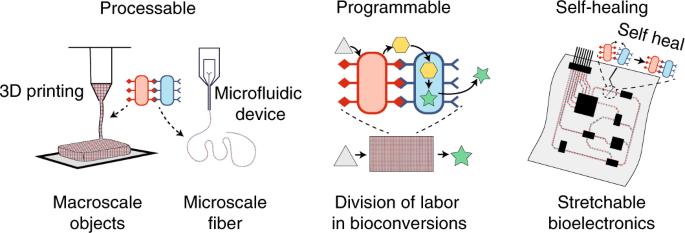Programmable living assembly of materials by bacterial adhesion
IF 13.7
1区 生物学
Q1 BIOCHEMISTRY & MOLECULAR BIOLOGY
引用次数: 25
Abstract
The field of engineered living materials aims to construct functional materials with desirable properties of natural living systems. A recent study demonstrated the programmed self-assembly of bacterial populations by engineered adhesion. Here we use this strategy to engineer self-healing living materials with versatile functions. Bacteria displaying outer membrane-anchored nanobody–antigen pairs are cultured separately and, when mixed, adhere to each other to enable processing into functional materials, which we term living assembled material by bacterial adhesion (LAMBA). LAMBA is programmable and can be functionalized with extracellular moieties up to 545 amino acids. Notably, the adhesion between nanobody–antigen pairs in LAMBA leads to fast recovery under stretching or bending. By exploiting this feature, we fabricated wearable LAMBA sensors that can detect bioelectrical or biomechanical signals. Our work establishes a scalable approach to produce genetically editable and self-healable living functional materials that can be applied in biomanufacturing, bioremediation and soft bioelectronics assembly. Bacterial populations, programmed to self-assemble by adhesion of nanobody–antigen pairs, can be processed into living materials (LAMBA) that are scalable, self-healing and programmable through functionalization with diverse proteins.

通过细菌粘附实现可编程活体材料组装
工程生物材料领域旨在构建具有自然生物系统理想特性的功能材料。最近的一项研究表明,细菌种群可通过工程粘附进行程序化自组装。在这里,我们利用这一策略来设计具有多种功能的自愈合活体材料。将显示外膜锚定纳米体-抗原对的细菌分别培养,混合后相互粘附,从而加工成功能材料,我们称之为细菌粘附活体组装材料(LAMBA)。LAMBA 是可编程的,可以用多达 545 个氨基酸的胞外分子进行功能化。值得注意的是,LAMBA 中的纳米体-抗原对之间的粘附作用可在拉伸或弯曲时快速恢复。利用这一特点,我们制造出了可穿戴的 LAMBA 传感器,可以检测生物电或生物力学信号。我们的工作建立了一种可扩展的方法,用于生产可基因编辑和自愈的活体功能材料,这些材料可应用于生物制造、生物修复和软生物电子组装。细菌种群通过粘附纳米体-抗原对进行程序化自组装,可加工成活材料(LAMBA),这种活材料通过与不同蛋白质的功能化,具有可扩展性、自愈性和可编程性。
本文章由计算机程序翻译,如有差异,请以英文原文为准。
求助全文
约1分钟内获得全文
求助全文
来源期刊

Nature chemical biology
生物-生化与分子生物学
CiteScore
23.90
自引率
1.40%
发文量
238
审稿时长
12 months
期刊介绍:
Nature Chemical Biology stands as an esteemed international monthly journal, offering a prominent platform for the chemical biology community to showcase top-tier original research and commentary. Operating at the crossroads of chemistry, biology, and related disciplines, chemical biology utilizes scientific ideas and approaches to comprehend and manipulate biological systems with molecular precision.
The journal embraces contributions from the growing community of chemical biologists, encompassing insights from chemists applying principles and tools to biological inquiries and biologists striving to comprehend and control molecular-level biological processes. We prioritize studies unveiling significant conceptual or practical advancements in areas where chemistry and biology intersect, emphasizing basic research, especially those reporting novel chemical or biological tools and offering profound molecular-level insights into underlying biological mechanisms.
Nature Chemical Biology also welcomes manuscripts describing applied molecular studies at the chemistry-biology interface due to the broad utility of chemical biology approaches in manipulating or engineering biological systems. Irrespective of scientific focus, we actively seek submissions that creatively blend chemistry and biology, particularly those providing substantial conceptual or methodological breakthroughs with the potential to open innovative research avenues. The journal maintains a robust and impartial review process, emphasizing thorough chemical and biological characterization.
 求助内容:
求助内容: 应助结果提醒方式:
应助结果提醒方式:


